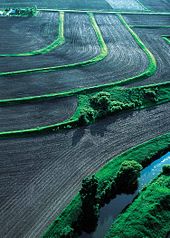| Revision as of 09:19, 28 September 2018 editConnieMuller (talk | contribs)1 editNo edit summaryTag: Visual edit← Previous edit | Revision as of 14:08, 28 September 2018 edit undoMoreau1 (talk | contribs)Extended confirmed users7,074 edits →External links: rv linkspamNext edit → | ||
| Line 70: | Line 70: | ||
| * - Erosion Control Educational Video Resource | * - Erosion Control Educational Video Resource | ||
| * - Erosion Control subsection of a website on Riparian Habitat Restoration | * - Erosion Control subsection of a website on Riparian Habitat Restoration | ||
| * - Soil and water management method | |||
| * - Groenkreatief Markvoort Holten, Netherlands | |||
| * - Engineering feasible studies and solutions to erosion control | |||
| {{Rivers, streams and springs}} | {{Rivers, streams and springs}} | ||
| {{Viticulture}} | {{Viticulture}} | ||
Revision as of 14:08, 28 September 2018


Erosion control is the practice of preventing or controlling wind or water erosion in agriculture, land development, coastal areas, river banks and construction. Effective erosion controls handle surface runoff and are important techniques in preventing water pollution, soil loss, wildlife habitat loss and human property loss.
Usage
Erosion controls are used in natural areas, agricultural settings or urban environments. In urban areas erosion controls are often part of stormwater runoff management programs required by local governments. The controls often involve the creation of a physical barrier, such as vegetation or rock, to absorb some of the energy of the wind or water that is causing the erosion. They also involve building and maintaining storm drains. On construction sites they are often implemented in conjunction with sediment controls such as sediment basins and silt fences.
Bank erosion is a natural process: without it, rivers would not meander and change course. However, land management patterns that change the hydrograph and/or vegetation cover can act to increase or decrease channel migration rates. In many places, whether or not the banks are unstable due to human activities, people try to keep a river in a single place. This can be done for environmental reclamation or to prevent a river from changing course into land that is being used by people. One way that this is done is by placing riprap or gabions along the bank.
Examples
Examples of erosion control methods include:
- buffer strip
- cellular confinement systems
- crop rotation
- conservation tillage
- contour bunding
- contour plowing
- cover crops
- fiber rolls
- gabions
- hydroseeding
- level spreaders
- mulching
- perennial crops
- plasticulture
- polyacrylamide (as a coagulant)
- reforestation
- riparian buffer
- riprap
- strip farming
- sand fence
- vegetated waterway (bioswale)
- terracing
- wattle (construction)
- windbreaks
Mathematical modeling
Since the 1920s and 1930s scientists have been creating mathematical models for understanding the mechanisms of soil erosion and resulting sediment surface runoff, including an early paper by Albert Einstein applying Baer's law. These models have addressed both gully and sheet erosion. Earliest models were a simple set of linked equations which could be employed by manual calculation. By the 1970s the models had expanded to complex computer models addressing nonpoint source pollution with thousands of lines of computer code. The more complex models were able to address nuances in micrometeorology, soil particle size distributions and micro-terrain variation.
See also
- Bridge scour
- Burned area emergency response
- Certified Professional in Erosion and Sediment Control
- Coastal management
- Dust Bowl
- Natural Resources Conservation Service (United States)
- Universal Soil Loss Equation
- Vetiver System
Notes
- State of California Department of Transportation, Division of Environmental Analysis, Stormwater Program. Sacramento, CA."Cellular Confinement System Research." 2006.
- Tennessee Department of Environment and Conservation. Nashville, TN."Tennessee Erosion and Sediment Control Handbook." 2002.
- Robert E. Horton. 1933
- Albert Einstein. 1926
- C. Michael Hogan, Leda Patmore, Gary Latshaw, Harry Seidman et al. 1973
References
- Albert Einstein. 1926. Die Ursache der Mäanderbildung der Flußläufe und des sogenannten Baerschen Gesetzes, Die Naturwissenschaften, 11, S. 223–224
- C. Michael Hogan, Leda Patmore, Gary Latshaw, Harry Seidman et al. 1973. Computer modeling of pesticide transport in soil for five instrumented watersheds, U.S. Environmental Protection Agency Southeast Water laboratory, Athens, Ga. by ESL Inc., Sunnyvale, California
- Robert E. Horton. 1933. The Horton Papers
- U.S. Natural Resources Conservation Service (NRCS). Washington, DC. "National Conservation Practice Standards." National Handbook of Conservation Practices. Accessed 2009-03-28.
External links
- "Saving Runaway Farm Land", November 1930, Popular Mechanics One of the first articles on the problem of soil erosion control
- Erosion Control Technology Council - a trade organization that mission is to educate and standardize the erosion control industry
- International Erosion Control Association - Professional Association, Publications, Training
- WatchYourDirt.com - Erosion Control Educational Video Resource
- Soil Bioengineering and Biotechnical Slope Stabilization - Erosion Control subsection of a website on Riparian Habitat Restoration
| Viticulture | |
|---|---|
| Biology and horticulture | |
| Environmental variation | |
| Vineyard planting | |
| Vineyard management | |
| Harvest | |
| Pests and diseases | |
| Approaches and issues | |
| See also | |